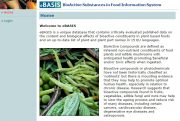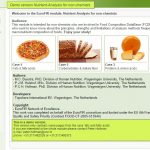Discover food data through our webtools
EuroFIR webtools
EuroFIR AISBL has developed a number of webtools with its members to access our food composition data. The tools bring together our datasets, and sometimes with other databases, to allow our members to exploit the data for research and providing other food and nutrition services. Please see below some information about each webtool and how to access them.-
 FoodEXplorer is an innovative interface for food composition data which allows users to search information from most EU Member States as well as Canada and USA, simultaneously. Ordinary Members have access to a wide range of data, linking foods and nutrients through harmonised data description (LanguaL), standardised components and value description with the use of EuroFIR thesauri (standard vocabularies) and associated nutrient value information. Replacing eSearch, FoodEXplorer includes options to search for food by name, food groups and the most common LanguaL food description. FoodEXplorer is much more powerful, and has the unique ability to compare component values between foods from the several countries. Results can be downloaded as a Food Data Transport Package (FDTP).
FoodEXplorer is an innovative interface for food composition data which allows users to search information from most EU Member States as well as Canada and USA, simultaneously. Ordinary Members have access to a wide range of data, linking foods and nutrients through harmonised data description (LanguaL), standardised components and value description with the use of EuroFIR thesauri (standard vocabularies) and associated nutrient value information. Replacing eSearch, FoodEXplorer includes options to search for food by name, food groups and the most common LanguaL food description. FoodEXplorer is much more powerful, and has the unique ability to compare component values between foods from the several countries. Results can be downloaded as a Food Data Transport Package (FDTP). -
 ePlantLIBRA is a database containing information about plant- and plant-food supplements specifically bioactive compounds in botanicals and herbal extracts with putative health benefits and adverse effects.
ePlantLIBRA is based on three existing databases: eBASIS (Bioactive Substances in Food Information System), developed by EuroFIR; the MoniQA contaminants database (FP6 Monitoring and Quality Assurance in the total food supply chain); and FERA’s HorizonScan database.
Scientific names, plant families, synonyms, common names in 15 European languages, colour photographs to aid identification and links to the Germplasm Resources Information Network (GRIN), together with details on edible parts, colour, size and shape, have been included for the plants in ePlantLIBRA. LanguaL has been used to code food descriptions.
ePlantLIBRA is a database containing information about plant- and plant-food supplements specifically bioactive compounds in botanicals and herbal extracts with putative health benefits and adverse effects.
ePlantLIBRA is based on three existing databases: eBASIS (Bioactive Substances in Food Information System), developed by EuroFIR; the MoniQA contaminants database (FP6 Monitoring and Quality Assurance in the total food supply chain); and FERA’s HorizonScan database.
Scientific names, plant families, synonyms, common names in 15 European languages, colour photographs to aid identification and links to the Germplasm Resources Information Network (GRIN), together with details on edible parts, colour, size and shape, have been included for the plants in ePlantLIBRA. LanguaL has been used to code food descriptions.
Find out more about ePLANTLIBRA here!
Access ePLANTLIBRA here!
-
 eBASIS The EuroFIR eBASIS (Bioactive Substances in Food Information Systems) is a unique Internet deployed food composition and biological effects database for plant-based bioactive compounds with putative health benefits. Over 300 major European plant foods are listed and information on 17 compound classes (e.g. phytosterols, polyphenols, glucosinolates and lignans) is provided covering multiple bioactive compound classes and plant foods, with data sourced from peer-reviewed literature.
A standardised approach to quality assurance of literature searching, data evaluation and reporting has been incorporated throughout the design, construction and delivery of the database. The quality assurance systems in EuroFIR eBASIS are supported by standard operating procedures (SOPs) and full documentation of decisions and procedures.
eBASIS The EuroFIR eBASIS (Bioactive Substances in Food Information Systems) is a unique Internet deployed food composition and biological effects database for plant-based bioactive compounds with putative health benefits. Over 300 major European plant foods are listed and information on 17 compound classes (e.g. phytosterols, polyphenols, glucosinolates and lignans) is provided covering multiple bioactive compound classes and plant foods, with data sourced from peer-reviewed literature.
A standardised approach to quality assurance of literature searching, data evaluation and reporting has been incorporated throughout the design, construction and delivery of the database. The quality assurance systems in EuroFIR eBASIS are supported by standard operating procedures (SOPs) and full documentation of decisions and procedures.
Find out more about eBASIS here!
Access eBASIS here!
 EuroFIR Theasauri: Use of special standardised controlled vocabularies (thesauri) for food composition data (FCD) description is one of the key elements of harmonised and standardised EuroFIR specifications for FCD processing. The specifications are based on a relational database model containing four main and other additional entities. The four main entities (Food, Component, Value, Reference) are mandatory for data documentation and they build the core set that is necessary for proper description of FCD.
The description of the food is regulated through the LanguaLTM Thesaurus. Its web page provides access to current and archival versions of the thesaurus, information about updating and other topics, and access to the Food Product Indexer tool to help describing the foods.
EuroFIR Theasauri: Use of special standardised controlled vocabularies (thesauri) for food composition data (FCD) description is one of the key elements of harmonised and standardised EuroFIR specifications for FCD processing. The specifications are based on a relational database model containing four main and other additional entities. The four main entities (Food, Component, Value, Reference) are mandatory for data documentation and they build the core set that is necessary for proper description of FCD.
The description of the food is regulated through the LanguaLTM Thesaurus. Its web page provides access to current and archival versions of the thesaurus, information about updating and other topics, and access to the Food Product Indexer tool to help describing the foods.
Find out more about EuroFIR Thesauri here!
 elearning modules The elearning modules are ideal for users of food composition information who want to know more about the principles, strenghts and limitations of analysis methodes to determine:
elearning modules The elearning modules are ideal for users of food composition information who want to know more about the principles, strenghts and limitations of analysis methodes to determine: -
- Macronutrient Module 1) composition
-
- Vitamins (Module 2) nutrients
